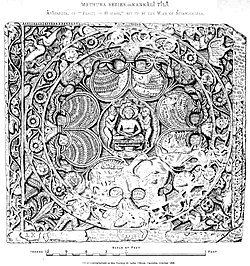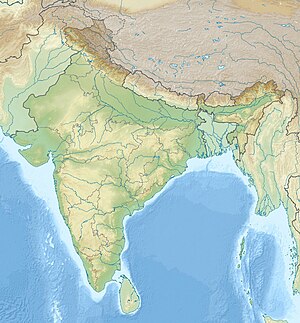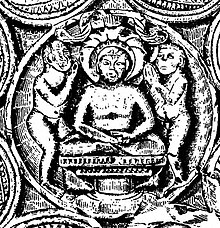Parsvanatha ayagapata
| Pārśvanātha Āyāgapaṭa | |
|---|---|
 | |
| Type | Ayagapata |
| Material | Red sandstone |
| Size | 86 by 94 centimetres (34 by 37 in) |
| Created | circa 15 CE |
| Period/culture | Northern Satraps |
| Discovered | January 1891 27°36′00″N 77°39′00″E |
| Place | Kankali Tila, Mathura, India. |
| Present location | State Museum Lucknow |
| Classification | Jain art |
 Kankali Tila, Mathura, (Discovery) | |
The Pārśvanātha āyāgapaṭa, is a large stone slab discovered in Kankali (area of Mathura) which has an image of Parshvanatha, dating back to reign Sodasa, of Indo-Scythian Northern Satrap, the ruler Sodasa in Mathura.[1] The tablet in the State Museum Lucknow (room J.253).[2][3] It is an important example of Mathura art.
Description
[edit]
This votive tablet, which is essentially an ayagapata, though not so called, represents an image of Parshvanatha in the center surrounded by a bunches of lotus.[4] Parshvanatha is depicted in lotus position seated on a pedestal with a seven-hooded sesha hood above his head.[5] The iconography flanked by two ardhaphalaka monks with colapatta draped over left arms, with their hands in añjali mudrā.[6][7] Similar to Dhanamitra ayagapata, Parshvanatha is in dhyāna mudrā with ankle crossed in padmasana position and shrivatsa on the chest.[8][9] The moulding of sawtooth design below the pedestal on which Jina is seated is considered to be a version of Mount Meru type of pedestal, which underscores Jina seated on the axis of the world.[10]
Surrounding the central circle in a larger concentric ring with four nandavarta, between each interstice of nandavarta is a half-opened lotus flanked by two smaller buds. In four spandrels there are carvings of different motifs namely an elephant frolicking with lotuses, a seated lion, honeysuckle, and rearing gryphons with lotus in their mouth. There is a carving of a grapevine growing out of a pot at the median on the left border.[10]
Inscription
[edit]The inscription at the base is much mutilated. The characters are of an archaic type before the Kushan era.[5] What is left of the record reads as follows:
Namo arahaňtânâ Sivagho[shaka] sa bhari[yá] ... nâ ... nâ
"Adoration to the Arhats! .... the wife of Sivaghoshaka ...."
— Inscription of the Parsvanatha ayagapata (Translation by Alois Anton Führer)[11]
Date
[edit]The Parsvanatha ayagapata was originally dated back to 1st century BCE by Bühler.[12] However, was later identified by Quintanilla to be datable to c. 15 CE during the reign Sodasa, of Indo-Scythian Northern Satrap, the ruler Sodasa in Mathura.[1][3][13]
See also
[edit]References
[edit]Citations
[edit]- ^ a b Quintanilla 2007, p. 200.
- ^ Mishra 1999, p. 163.
- ^ a b Quintanilla 2007, p. 406.
- ^ Quintanilla 2000, p. 106.
- ^ a b Smith 1901, p. 17.
- ^ Quintanilla 2007, p. 131.
- ^ Sethia 2004, p. 211.
- ^ Vyas & Shah 1995, p. 16.
- ^ Shah 1987, p. 171.
- ^ a b Quintanilla 2007, p. 123.
- ^ Burgess & Führer 1894, p. 207.
- ^ Smith 1901, p. 5.
- ^ Obbink 1949, p. 244.
Sources
[edit]- Burgess, James; Führer, A. (1894). Epigraphia Indica. Vol. 2. Calcutta: Superintendent, Government Press.
- Mishra, P. K. (1999). Studies in Hindu and Buddhist Art. Abhinav Publications. ISBN 9788170173687.
- Shah, Umakant Premanand (1987), Jaina-rūpa-maṇḍana: Jaina iconography, Abhinav Publications, ISBN 978-81-7017-208-6
- Sethia, Tara (2004). Ahimsā, Anekānta, and Jainism. Lala Sunder Lal Jain research series. Vol. 21. Motilal Banarsidass. ISBN 9788120820364.
- Smith, Vincent A. (1901). Jain Stupa and other antiquitie (PDF). Vol. 20. Allahabad: Superintendent, Government Press.
- Obbink, Hendrik Willem (1949). Orientalia Rheno-traiectina. Vol. 2. Brill Publishers.
- Quintanilla, Sonya Rhie (2007). History of Early Stone Sculpture at Mathura: Ca. 150 BCE - 100 CE. Brill Publishers. ISBN 9789004155374.
- Quintanilla, Sonya Rhie (2000). "Āyāgapaṭas: Characteristics, Symbolism, and Chronology". Artibus Asiae. 60 (1): 79–137. doi:10.2307/3249941. JSTOR 3249941. Retrieved 20 April 2022.
- Vyas, R. T.; Shah, Umakant Premanand (1995). Studies in Jaina Art and Iconography and Allied Subjects in Honour of Dr. U.P. Shah. Abhinav Publications. ISBN 9788170173168.
External links
[edit]![]() Media related to Parsvanatha ayagapata at Wikimedia Commons
Media related to Parsvanatha ayagapata at Wikimedia Commons
